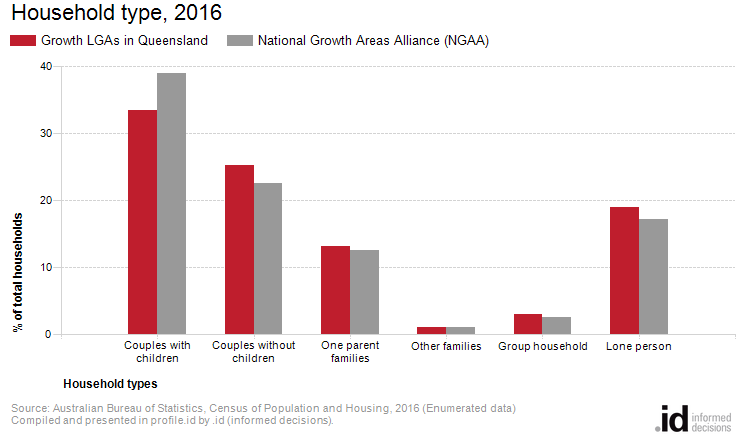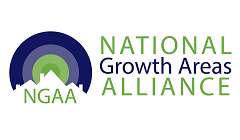Growth LGAs in Queensland
Household type
In Growth LGAs in Queensland, 33.5% of households were made up of couples with children in 2016, compared with 38.9% in National Growth Areas Alliance (NGAA).
Growth LGAs in Queensland's household and family structure is one of the most important demographic indicators. It reveals the area's residential role and function, era of settlement and provides key insights into the level of demand for services and facilities as most are related to age and household types.
To continue building the story, Growth LGAs in Queensland's Household Summary should be viewed in conjunction with Households with Children, Households without Children, Household Size, Age Structure and Dwelling Type.
If you're looking at this data to prepare a housing strategy, learn more here.
Derived from the Census question:
'What is the person's relationship (to each other person in the household)?'
Households
| Household type | ||||||||
|---|---|---|---|---|---|---|---|---|
| Growth LGAs in Queensland - Total households (Enumerated) | 2016 | 2011 | Change | |||||
| Households by type | Number | % | National Growth Areas Alliance (NGAA) % | Number | % | National Growth Areas Alliance (NGAA) % | 2011 to 2016 | |
| Couples with children | 127,340 | 33.5 | 38.9 | 119,023 | 34.9 | 39.0 | +8,317 | 19500 |
| Couples without children | 95,882 | 25.2 | 22.6 | 88,488 | 25.9 | 23.5 | +7,394 | 19501 |
| One parent families | 49,874 | 13.1 | 12.6 | 44,279 | 13.0 | 12.9 | +5,595 | 19502 |
| Other families | 4,020 | 1.1 | 1.1 | 3,555 | 1.0 | 1.1 | +465 | 19503 |
| Group household | 11,622 | 3.1 | 2.5 | 10,315 | 3.0 | 2.5 | +1,307 | 19504 |
| Lone person | 72,242 | 19.0 | 17.2 | 63,771 | 18.7 | 17.4 | +8,471 | 19505 |
| Other not classifiable household | 16,826 | 4.4 | 4.4 | 9,587 | 2.8 | 3.0 | +7,239 | 19506 |
| Visitor only households | 2,492 | 0.7 | 0.6 | 2,225 | 0.7 | 0.6 | +267 | 19507 |
| Total households | 380,298 | 100.0 | 100.0 | 341,243 | 100.0 | 100.0 | +39,055 | |
Source: Australian Bureau of Statistics, Census of Population and Housing (opens a new window) 2011 and 2016. Compiled and presented by .id (opens a new window)(informed decisions).
(Enumerated data)

Compiled and presented in profile.id by .id (informed decisions).

Compiled and presented in profile.id by .id (informed decisions).
Dominant groups
Analysis of the household/family types in Growth LGAs in Queensland in 2016 compared to National Growth Areas Alliance (NGAA) shows that there was a lower proportion of couple families with child(ren) as well as a similar proportion of one-parent families. Overall, 33.5% of total families were couple families with child(ren), and 13.1% were one-parent families, compared with 38.9% and 12.6% respectively for National Growth Areas Alliance (NGAA).
There were a higher proportion of lone person households and a higher proportion of couples without children. Overall, the proportion of lone person households was 19.0% compared to 17.2% in National Growth Areas Alliance (NGAA) while the proportion of couples without children was 25.2% compared to 22.6% in National Growth Areas Alliance (NGAA).
Emerging groups
The number of households in Growth LGAs in Queensland increased by 39,055 between 2011 and 2016.
The largest changes in family/household types in Growth LGAs in Queensland between 2011 and 2016 were:
- Lone person (+8,471 households)
- Couples with children (+8,317 households)
- Couples without children (+7,394 households)
- One parent families (+5,595 households)
